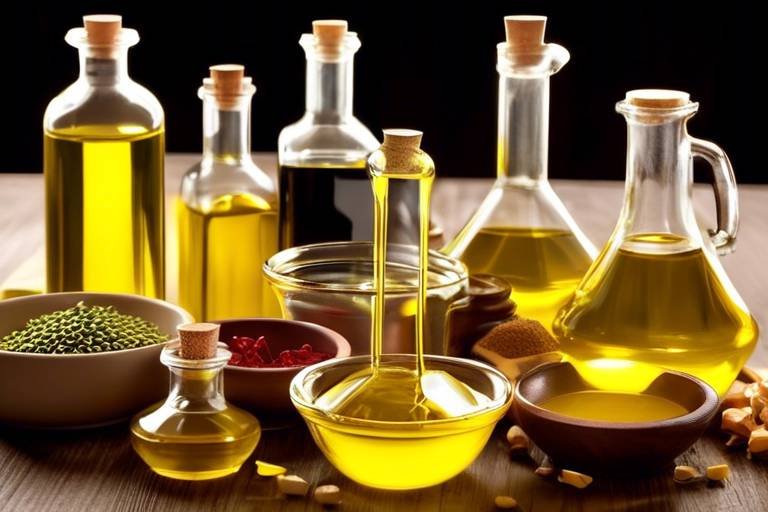The Chemistry of Cooking Oils - Choosing the Right One
Cooking oils are more than just a means to sauté vegetables or fry up a delicious batch of chicken—they are the unsung heroes of the culinary world. The right cooking oil can enhance flavors, improve textures, and even contribute to the nutritional value of your meals. With a plethora of options available, it’s crucial to understand the chemistry behind cooking oils to make informed choices that suit your cooking style and health needs.
So, what makes cooking oils tick? At their core, cooking oils are composed of various types of fats, which can be broadly classified into saturated, monounsaturated, and polyunsaturated fats. Each type has its own unique properties and health implications. For instance, oils rich in monounsaturated fats, like olive oil, are celebrated for their heart-health benefits, while those high in saturated fats, such as coconut oil, can be a bit more controversial. Understanding these differences is essential for anyone looking to maintain a balanced diet.
Furthermore, the extraction method plays a significant role in determining the quality and flavor profile of the oil. Cold-pressed oils, for example, retain more nutrients and flavor compared to refined oils, which undergo extensive processing. This distinction can affect not only the health benefits of the oil but also its taste in your dishes. Imagine using a high-quality extra virgin olive oil drizzled over a fresh salad versus a bland, refined version; the difference is striking!
Choosing the right cooking oil also hinges on its smoke point, which refers to the temperature at which the oil begins to smoke and break down. Using an oil with a low smoke point for frying can lead to unpleasant flavors and harmful compounds. For instance, olive oil has a relatively low smoke point compared to oils like avocado or canola, making it better suited for dressings or low-heat cooking. Understanding these nuances can elevate your cooking game and ensure that you’re making the healthiest choices for your meals.
In summary, the chemistry of cooking oils is a fascinating topic that intertwines flavor, health, and culinary techniques. By understanding the types of fats, extraction methods, and smoke points, you can confidently choose the right oil for your kitchen adventures. Whether you’re frying, sautéing, or simply dressing a salad, the right cooking oil can make all the difference. So next time you reach for that bottle of oil, remember: it’s not just cooking; it’s chemistry in action!
- What is the healthiest cooking oil? The healthiest cooking oil often depends on your dietary needs, but oils high in monounsaturated fats, such as olive oil, are generally considered beneficial for heart health.
- Can I use olive oil for frying? While you can use olive oil for frying, it’s best suited for low to medium heat cooking. For high-temperature frying, consider oils with a higher smoke point, like avocado oil.
- What are trans fats and why should I avoid them? Trans fats are artificially created fats that can increase bad cholesterol levels and lower good cholesterol levels, posing significant health risks. Always check labels to avoid oils containing trans fats.
- How can I store cooking oils properly? To extend the shelf life of cooking oils, store them in a cool, dark place, away from heat and light, and ensure the cap is tightly sealed after each use.

Understanding Cooking Oils
Cooking oils play a pivotal role in the culinary world, serving not just as a medium for frying, sautéing, or baking, but also as a key ingredient that enhances the flavor, texture, and nutritional value of our dishes. At their core, cooking oils are fats that are extracted from various sources, including plants, nuts, and seeds. Each oil possesses a unique blend of fatty acids, vitamins, and antioxidants, which contribute to their distinct characteristics and uses in the kitchen.
When we talk about cooking oils, it's essential to understand their composition. Most cooking oils consist of a mix of saturated, monounsaturated, and polyunsaturated fats. These fats are crucial not only for cooking but also for our health. For example, oils rich in monounsaturated fats, like olive oil, are known for their heart health benefits, while oils high in polyunsaturated fats, such as sunflower oil, can provide essential fatty acids that our bodies cannot produce on their own.
Moreover, the extraction method of an oil can significantly impact its quality and flavor. For instance, cold-pressed oils are extracted without heat, preserving their natural flavors and nutrients, making them ideal for dressings and drizzling. On the other hand, refined oils undergo processing that often strips away some of their natural properties, resulting in a more neutral flavor that can be suitable for high-heat cooking.
In addition to their health benefits, cooking oils also contribute to the culinary experience. The right oil can elevate a dish from mundane to extraordinary. For instance, frying with a high smoke point oil can create a crispy texture, while drizzling a flavorful oil over a salad can enhance its taste profile. Understanding the various types of oils available and their specific applications can make a significant difference in the outcome of your cooking.
To summarize, cooking oils are more than just a cooking medium; they are a vital component of our meals that can influence both health and flavor. As we delve deeper into the world of cooking oils, we'll explore the different types available, their unique properties, and how to choose the right one for your culinary needs.

Types of Cooking Oils
When it comes to cooking oils, the variety can be as vast as the culinary world itself! Each type of oil brings its own unique flavor, aroma, and nutritional profile to the table. Understanding these differences is essential for any home cook or culinary enthusiast. So, let’s dive into the different categories of cooking oils and what makes them special.
Cooking oils can generally be categorized into three main types: vegetable oils, nut oils, and seed oils. Each of these categories has its own distinct properties and uses in the kitchen. For instance, vegetable oils are often neutral in flavor, making them perfect for frying and baking, while nut and seed oils can add a rich, nutty taste to dishes.
Vegetable oils are perhaps the most common type of cooking oil found in kitchens around the world. Derived from various plants, these oils are extracted through pressing or refining processes. They are typically light in flavor, which allows the natural taste of the food to shine through. Some popular vegetable oils include canola oil, corn oil, and soybean oil. These oils are versatile and can be utilized in a variety of cooking techniques, from sautéing to baking.
Next up, we have nut oils. These oils are extracted from nuts and are known for their robust flavors and health benefits. For example, almond oil is not only delicious but also packed with vitamin E, while hazelnut oil can add a delightful twist to salad dressings. Nut oils are often used in gourmet cooking and are best suited for drizzling over dishes or used in dressings rather than high-heat cooking.
Seed oils, on the other hand, come from the seeds of various plants and can vary significantly in flavor and nutritional value. Sesame oil is a popular choice in Asian cuisine, known for its rich, nutty flavor, while flaxseed oil is prized for its omega-3 fatty acid content. These oils can enhance the taste of dishes, but similar to nut oils, they are generally better used in dressings or as finishing oils rather than for frying.
To summarize, here’s a quick look at the types of cooking oils:
| Type of Oil | Common Examples | Best Uses |
|---|---|---|
| Vegetable Oils | Canola, Corn, Soybean | Frying, Baking, Sautéing |
| Nut Oils | Almond, Hazelnut, Walnut | Drizzling, Dressings, Baking |
| Seed Oils | Sesame, Flaxseed, Sunflower | Dressings, Finishing |
Choosing the right cooking oil is not just about flavor; it’s also about health and nutrition. Each oil has its own unique profile of fatty acids, vitamins, and antioxidants, which can influence your overall well-being. So, next time you reach for that bottle of oil, consider what you’re cooking and the benefits each type can offer. The right oil can elevate your dishes while also contributing positively to your health!
- What is the healthiest cooking oil? The healthiest cooking oil can depend on your dietary needs, but oils like olive oil and avocado oil are often recommended for their beneficial fats and antioxidants.
- Can I use any cooking oil for frying? Not all oils are suitable for frying. Oils with high smoke points, like canola and peanut oil, are best for frying.
- Are nut oils safe for cooking? Yes, but it's best to use nut oils for low to medium heat cooking or as finishing oils to preserve their flavor and nutrients.

Vegetable Oils
When it comes to cooking, are the unsung heroes of our kitchens. These oils are derived from various plant sources, and their versatility makes them a staple in countless culinary practices around the world. From frying to baking, vegetable oils not only enhance the flavor of dishes but also contribute to their texture and nutritional profile. Understanding the different types of vegetable oils and their unique properties can empower you to make informed choices in your cooking endeavors.
Vegetable oils are typically extracted from seeds, nuts, or fruits, and their extraction methods can vary significantly. Common methods include cold pressing, where oil is extracted without heat to preserve flavor and nutrients, and refining, which involves processing the oil to remove impurities and extend shelf life. Each method affects the oil's flavor, color, and smoke point, making it essential to choose the right oil for your cooking needs.
Some of the most popular vegetable oils include:
- Canola Oil: Known for its mild flavor and high smoke point, canola oil is a favorite for frying and baking.
- Sunflower Oil: With a light taste and high smoke point, sunflower oil is great for frying and sautéing.
- Soybean Oil: Often used for its affordability and versatility, soybean oil is commonly found in processed foods.
- Corn Oil: This oil has a slightly sweet flavor and is often used in frying and salad dressings.
Each of these oils brings its own set of benefits and flavors to the table, making them suitable for different culinary applications. For instance, canola oil is rich in omega-3 fatty acids, which are beneficial for heart health, while sunflower oil is high in vitamin E, an antioxidant that helps protect your body from oxidative stress.
In conclusion, understanding the various types of vegetable oils and their characteristics can significantly enhance your cooking experience. Whether you're frying, sautéing, or baking, choosing the right vegetable oil can elevate your dishes and contribute to a healthier diet.
Here are some common questions about vegetable oils:
- What is the healthiest vegetable oil? - Olive oil is often considered the healthiest due to its high content of monounsaturated fats and antioxidants.
- Can I use vegetable oil for baking? - Yes, vegetable oils like canola and sunflower are excellent for baking as they provide moisture without altering the flavor significantly.
- Are all vegetable oils the same? - No, each vegetable oil has different properties, flavors, and nutritional profiles, making them suitable for various cooking methods.

Canola Oil
Canola oil is one of the most popular cooking oils around the globe, and for good reason! With its mild flavor and impressive high smoke point of about 400°F (204°C), it’s incredibly versatile. Whether you're frying, baking, or sautéing, canola oil can handle the heat without breaking down, making it a kitchen staple for many home cooks and professional chefs alike. But what really sets canola oil apart are its health benefits, particularly its rich content of omega-3 fatty acids. These essential fats are crucial for heart health, helping to lower bad cholesterol levels and reduce the risk of heart disease.
Canola oil is extracted from the seeds of the canola plant, which is a type of rapeseed. The extraction process often involves refining, which helps remove impurities and gives the oil its light color and flavor. This refining process, however, also means that some nutrients may be lost. For those looking for a more nutrient-dense option, cold-pressed canola oil is available, retaining more of its natural flavor and health benefits.
When it comes to cooking, canola oil is a true chameleon. Here are some of its culinary applications:
- Frying: Perfect for deep frying due to its high smoke point.
- Baking: Adds moisture without overpowering the flavor of baked goods.
- Sautéing: Ideal for stir-fries and other quick-cooking methods.
- Dressings: Can be used as a base for salad dressings, providing a light texture.
In addition to its culinary versatility, canola oil is also a great source of vitamin E, an antioxidant that helps protect your body’s cells from damage. This combination of health benefits and cooking flexibility makes canola oil a go-to choice for many health-conscious individuals. However, it’s essential to be mindful of the quality of the oil you choose. Opt for organic or non-GMO canola oil whenever possible to avoid the potential downsides of conventional farming practices.
In summary, canola oil stands out not just for its cooking prowess but also for its nutritional benefits. It’s a fantastic choice for anyone looking to maintain a healthy diet while enjoying a wide variety of culinary experiences. So, the next time you're in the kitchen, don’t hesitate to reach for that bottle of canola oil; it just might become your new best friend!

Olive Oil
When it comes to cooking oils, holds a special place in the hearts of many chefs and home cooks alike. Its rich flavor and numerous health benefits make it a staple in kitchens around the world. But what exactly sets olive oil apart from other oils? Let's dive into the details!
First off, it's important to understand that not all olive oils are created equal. The two most common types you'll encounter are extra virgin olive oil and regular olive oil. Extra virgin olive oil is made from pure, cold-pressed olives and is the highest quality available. It retains the natural flavors and antioxidants, making it a fantastic choice for drizzling over salads or finishing off a dish. On the other hand, regular olive oil is refined and has a more neutral flavor, which can be better suited for cooking at higher temperatures.
One of the standout features of olive oil is its impressive health profile. It is rich in monounsaturated fats, which are known to support heart health. These healthy fats can help lower bad cholesterol levels and reduce the risk of heart disease. Plus, olive oil is packed with antioxidants, particularly polyphenols, which have anti-inflammatory properties and may even protect against certain chronic diseases.
When it comes to cooking, olive oil is incredibly versatile. You can use it for:
- Sautéing vegetables
- Marinating meats
- Baking
- Making dressings and dips
However, it’s crucial to note that olive oil has a moderate smoke point, typically around 375°F (190°C). This means it’s best to avoid using it for high-heat frying, as it can start to smoke and lose its beneficial properties. Instead, reserve your extra virgin olive oil for low to medium-heat cooking or as a finishing touch to your favorite dishes.
In conclusion, incorporating olive oil into your cooking not only enhances flavors but also provides a wealth of health benefits. Whether you're drizzling it over a fresh salad or using it to sauté vegetables, olive oil is a delightful addition to any culinary repertoire. So next time you're at the store, consider reaching for a bottle of high-quality olive oil and experience the difference it can make in your cooking!

Nut and Seed Oils
Nut and seed oils are a delightful addition to any kitchen, bringing not just unique flavors but also a variety of health benefits. These oils are extracted from the seeds and nuts of various plants, and they often carry a distinct taste that can elevate your dishes to new heights. Imagine adding a splash of sesame oil to your stir-fry or drizzling some almond oil over a fresh salad; it’s like giving your meals a warm hug of flavor!
One of the most exciting aspects of nut and seed oils is their diverse range of applications in cooking. For instance, walnut oil is perfect for dressings and marinades due to its rich, nutty flavor, while pumpkin seed oil adds a luxurious touch to soups and roasted vegetables. The extraction methods also play a crucial role in determining the quality and flavor of these oils. Cold-pressed oils, for example, retain more nutrients and flavor compared to those extracted using heat or chemicals.
Here’s a quick look at some popular nut and seed oils and their culinary uses:
| Oil | Flavor Profile | Best Uses |
|---|---|---|
| Almond Oil | Light, slightly sweet | Salads, baking, drizzling |
| Sesame Oil | Rich, nutty | Stir-frying, dressings |
| Walnut Oil | Earthy, robust | Dressings, dips, finishing oil |
| Pumpkin Seed Oil | Nutty, slightly sweet | Soups, roasted veggies, drizzling |
In addition to their culinary uses, nut and seed oils are also packed with essential nutrients. They are often rich in vitamin E, antioxidants, and healthy fats, which can contribute to overall well-being. For example, the omega-3 fatty acids found in flaxseed oil are known for their heart health benefits and anti-inflammatory properties. However, it’s essential to store these oils properly, as they can go rancid quickly due to their high polyunsaturated fat content. Keep them in a cool, dark place and consume them within a few months for the best flavor and nutritional value.
As you explore the world of nut and seed oils, remember that they can transform simple dishes into culinary masterpieces. Whether you’re looking to enhance flavors, boost nutritional value, or simply try something new, these oils provide a plethora of options. So, why not experiment with them in your next dish? You might just discover your new favorite flavor!
- What are the health benefits of nut and seed oils? Nut and seed oils are rich in healthy fats, vitamins, and antioxidants, which can promote heart health and reduce inflammation.
- Can I use nut and seed oils for frying? Some nut and seed oils, like sesame oil, can be used for frying, but it's essential to check their smoke points to avoid burning.
- How should I store nut and seed oils? Store them in a cool, dark place, and use them within a few months to maintain their freshness and flavor.

Smoke Points of Oils
When it comes to cooking, the smoke point of an oil is a crucial factor that often gets overlooked. The smoke point is the temperature at which an oil begins to smoke and break down, producing harmful compounds and unpleasant flavors. Understanding smoke points is essential for selecting the right oil for your culinary endeavors. Different cooking methods require different oils, and knowing the smoke point can make all the difference between a delicious meal and a burnt disaster.
For instance, if you're planning to fry up some crispy chicken, you wouldn’t want to use an oil with a low smoke point, as it would start to smoke and impart a bitter taste to your dish. Instead, you’d reach for an oil with a high smoke point, allowing you to cook at higher temperatures without compromising flavor or safety. On the flip side, if you're preparing a fresh salad, a low smoke point oil like extra virgin olive oil can enhance your dressing without the risk of overheating it.
To give you a clearer picture, here’s a table that outlines some common cooking oils along with their respective smoke points:
| Cooking Oil | Smoke Point (°F) | Best Uses |
|---|---|---|
| Canola Oil | 400 | Frying, baking |
| Olive Oil (Extra Virgin) | 375 | Dressings, sautéing |
| Avocado Oil | 520 | High-heat cooking, frying |
| Peanut Oil | 450 | Frying, Asian dishes |
| Sesame Oil | 410 | Stir-frying, dressings |
As you can see from the table, oils like avocado and peanut oil have high smoke points, making them perfect for frying and other high-temperature cooking methods. In contrast, oils like extra virgin olive oil are better suited for lower-heat applications. This knowledge not only enhances your cooking skills but also promotes healthier eating habits by preventing the formation of harmful compounds.
In summary, understanding the smoke points of various oils empowers you to make informed choices in the kitchen. It’s not just about flavor; it’s about ensuring that your cooking techniques yield the best results without compromising your health. So, the next time you're whipping up a meal, consider the smoke point of your oil, and let it guide you to culinary success!
- What is the smoke point of an oil? The smoke point is the temperature at which an oil starts to smoke and break down, affecting flavor and health.
- Why is smoke point important? Using oils with appropriate smoke points ensures better flavor and reduces the formation of harmful compounds.
- Can I reuse cooking oil? Reusing oil can lower its smoke point, so it's best to avoid it, especially if the oil has been heated to a high temperature.
- Are there oils I should avoid heating? Yes, oils with low smoke points, like flaxseed oil, should not be heated and are best used in dressings or drizzles.

High Smoke Point Oils
When it comes to cooking, understanding the smoke point of oils is absolutely crucial. The smoke point is the temperature at which an oil begins to smoke and break down, releasing harmful compounds and unpleasant flavors. For high-heat cooking methods like frying, sautéing, or grilling, choosing an oil with a high smoke point is essential to maintain both the integrity of your food and your health. So, what are these high smoke point oils, and how can they elevate your cooking? Let's dive into it!
High smoke point oils typically have a smoke point of around 400°F (204°C) or higher. These oils are perfect for achieving that crispy, golden-brown finish we all love in fried foods. Some popular high smoke point oils include:
- Canola Oil - With a smoke point of approximately 400°F (204°C), canola oil is a versatile choice for frying and baking.
- Avocado Oil - This oil boasts a remarkable smoke point of about 520°F (271°C), making it one of the highest available. It's perfect for stir-frying or searing meats.
- Grapeseed Oil - With a smoke point around 420°F (216°C), grapeseed oil is excellent for sautéing and baking, offering a light flavor.
- Safflower Oil - This oil has a smoke point of about 450°F (232°C) and is great for frying due to its neutral taste.
- Peanut Oil - Popular in Asian cuisines, peanut oil has a smoke point of approximately 450°F (232°C), making it ideal for deep-frying.
Using high smoke point oils not only enhances the flavor of your dishes but also allows you to cook at higher temperatures without the risk of burning the oil. This is particularly important when you're aiming for that perfect sear on a steak or crispy fried chicken. However, it’s worth noting that while these oils are great for cooking, they still need to be used in moderation as part of a balanced diet.
Now, you might be wondering, how do you choose the right high smoke point oil for your specific needs? It often comes down to flavor preferences and the type of cooking you plan to do. For instance, if you're making a stir-fry, avocado oil’s subtle flavor and high smoke point make it a fantastic option. On the other hand, if you're frying up some spring rolls, peanut oil could add that authentic Asian touch.
In conclusion, high smoke point oils are indispensable in any kitchen, especially for those who enjoy cooking at elevated temperatures. They not only ensure that your food remains flavorful and healthy but also help you achieve those culinary techniques that make your dishes truly shine. Remember, the right oil can make all the difference in your cooking adventures!
Q: What is the smoke point of an oil?
A: The smoke point of an oil is the temperature at which it begins to smoke and break down, affecting flavor and health.
Q: Why is it important to use oils with high smoke points?
A: Oils with high smoke points are better suited for high-heat cooking methods, helping to prevent the release of harmful compounds.
Q: Can I reuse high smoke point oils?
A: Yes, you can reuse high smoke point oils, but it's essential to strain them and store them properly to maintain quality.
Q: Are there any health benefits to using high smoke point oils?
A: Many high smoke point oils, like avocado and canola oil, contain healthy fats and nutrients that can contribute to a balanced diet.

Low Smoke Point Oils
When it comes to cooking oils, understanding the concept of smoke points is essential for making informed choices in the kitchen. Low smoke point oils, typically defined as those with a smoke point below 350°F (175°C), are not suited for high-heat cooking methods like frying or sautéing. Instead, these oils shine in their own right, offering unique flavors and health benefits when used appropriately. Imagine using a delicate oil like flaxseed oil in a salad dressing instead of exposing it to high heat; it’s like wearing a fine silk shirt to a formal event rather than a rugged denim jacket!
Some popular low smoke point oils include extra virgin olive oil, sesame oil, and flaxseed oil. Each of these oils brings its own unique flavor profile and nutritional benefits, making them perfect for drizzling over dishes or incorporating into cold preparations. For example, extra virgin olive oil is celebrated not only for its rich taste but also for its antioxidant properties and heart-healthy fats. When you drizzle it over a fresh salad or use it as a dip for bread, you’re not just enhancing the flavor; you’re also boosting the nutritional value of your meal.
It's crucial to note that while these oils should not be heated, they can be used in a variety of ways that maximize their potential. Here are some common applications for low smoke point oils:
- Dressings and Marinades: Combine with vinegar or citrus juice for a flavorful dressing.
- Finishing Oil: Drizzle over cooked dishes to add a burst of flavor.
- Cold Dishes: Use in dips or spreads for added richness.
Incorporating low smoke point oils into your cooking can elevate your dishes while also providing health benefits. However, it’s essential to remember that heating these oils can lead to the formation of harmful compounds, which is why they are best enjoyed in their natural state. So the next time you're preparing a meal, consider reaching for an oil with a low smoke point to enhance flavors without the risk of burning.
Q: What are the best uses for low smoke point oils?
A: Low smoke point oils are ideal for dressings, marinades, and as finishing oils. They should not be used for frying or high-heat cooking.
Q: Can I use low smoke point oils in baking?
A: It’s generally not recommended to use low smoke point oils in baking, especially at high temperatures. Instead, use them in recipes that do not require cooking or at the end of cooking to preserve their flavor and nutritional benefits.
Q: How can I tell if an oil is low smoke point?
A: Most oils will have their smoke points listed on the label or can be found online. Oils like extra virgin olive oil, flaxseed oil, and sesame oil typically have lower smoke points.

Health Considerations
When it comes to cooking oils, choosing the right one isn't just about flavor or smoke point; it's also about health. The type of oil you use can significantly impact your overall well-being, particularly concerning heart health and the risk of chronic diseases. Understanding the nutritional profiles of various oils is essential for making informed choices that align with your health goals. For instance, oils rich in monounsaturated fats, like olive oil, are known to promote heart health, while oils high in saturated fats, such as coconut oil, should be consumed more cautiously.
Moreover, the fatty acid composition of oils plays a crucial role in determining their health benefits. Different oils contain varying proportions of saturated, monounsaturated, and polyunsaturated fats. To give you a clearer picture, here's a brief overview of these types of fats:
| Fat Type | Sources | Health Effects |
|---|---|---|
| Saturated Fats | Coconut oil, palm oil, animal fats | Can raise LDL cholesterol levels; consume in moderation |
| Monounsaturated Fats | Olive oil, canola oil, avocado oil | May lower bad cholesterol levels and reduce heart disease risk |
| Polyunsaturated Fats | Sunflower oil, soybean oil, flaxseed oil | Essential for body functions; includes omega-3 and omega-6 fatty acids |
Another critical aspect to consider is the presence of trans fats in cooking oils. Trans fats are often found in partially hydrogenated oils and are notorious for their adverse health effects, including increasing the risk of heart disease. It's essential to read labels carefully and avoid oils that contain trans fats. Many manufacturers now highlight the absence of trans fats on their packaging, making it easier for consumers to make healthier choices.
In conclusion, the health implications of cooking oils are profound. Selecting oils high in beneficial fats while steering clear of those laden with trans fats can make a significant difference in your diet. Remember, a little knowledge goes a long way in ensuring that your culinary choices contribute positively to your health.
- What is the healthiest cooking oil?
While there isn't a one-size-fits-all answer, oils like olive oil and avocado oil are often recommended for their health benefits, particularly their high levels of monounsaturated fats.
- Are all vegetable oils healthy?
Not necessarily. Some vegetable oils can be high in omega-6 fatty acids, which, when consumed excessively, may lead to inflammation. It's essential to choose oils wisely and consider their fatty acid profiles.
- Can I reuse cooking oil?
Reusing cooking oil can be safe if done correctly, but it's crucial to strain out food particles and store it in a cool, dark place. However, be cautious of the oil's smoke point and how many times it has been heated, as this can affect its safety and flavor.

Fatty Acid Composition
The of cooking oils plays a crucial role in determining not only their health benefits but also their culinary applications. Understanding these fatty acids can help you make informed choices about which oils to use in your cooking. There are three primary types of fatty acids found in cooking oils: saturated fats, monounsaturated fats, and polyunsaturated fats. Each of these has distinct properties and effects on health.
Saturated fats are typically solid at room temperature and are found in oils like coconut oil and palm oil. While they can add richness and flavor to dishes, excessive consumption of saturated fats can raise cholesterol levels, potentially leading to heart disease. It's essential to consume them in moderation and balance them with healthier fats.
Monounsaturated fats are liquid at room temperature and are considered heart-healthy. They are abundant in oils like olive oil and canola oil. These fats can help reduce bad cholesterol levels and provide essential nutrients. Incorporating monounsaturated fats into your diet is a fantastic way to promote cardiovascular health.
On the other hand, polyunsaturated fats are also liquid at room temperature and include omega-3 and omega-6 fatty acids. These fats are vital for brain function and cell growth. Oils such as flaxseed oil and sunflower oil are rich in polyunsaturated fats. However, it’s crucial to maintain a balance between omega-3 and omega-6 fatty acids, as an excess of omega-6 can lead to inflammation.
To give you a clearer picture of the fatty acid composition in some common cooking oils, here's a table summarizing their primary fatty acids:
| Cooking Oil | Saturated Fat (%) | Monounsaturated Fat (%) | Polyunsaturated Fat (%) |
|---|---|---|---|
| Olive Oil | 14 | 73 | 11 |
| Canola Oil | 7 | 63 | 30 |
| Coconut Oil | 82 | 6 | 2 |
| Sunflower Oil | 10 | 20 | 70 |
When selecting a cooking oil, consider not just the flavor but also the fatty acid profile. Oils high in monounsaturated fats are generally the best choice for everyday cooking, while those rich in polyunsaturated fats should be used with care to maintain a healthy balance in your diet. Remember, the key to a healthy diet is variety and moderation. By understanding the fatty acid composition of oils, you can enhance both the flavor of your dishes and your overall health.

Trans Fats
Trans fats are often considered the "bad boys" of the fat world. These artificial fats are created through a process called hydrogenation, where hydrogen is added to liquid oils to make them solid at room temperature. This process not only increases the shelf life of products but also enhances flavor and texture, making them appealing to manufacturers. However, the health implications of trans fats are alarming. Studies have shown that they can raise bad cholesterol (LDL) levels while simultaneously lowering good cholesterol (HDL) levels, leading to an increased risk of heart disease, stroke, and type 2 diabetes.
Identifying trans fats in cooking oils and processed foods can be tricky. They are often hidden under various names, such as "partially hydrogenated oils." To make informed choices, it’s crucial to read nutrition labels carefully. In fact, the FDA mandates that if a product contains less than 0.5 grams of trans fat per serving, it can be labeled as "trans fat-free." This can be misleading, as consuming multiple servings can easily add up to significant trans fat intake. Therefore, it’s wise to look for products that explicitly state they contain no trans fats.
Here’s a quick rundown of common sources of trans fats:
- Processed baked goods (cookies, cakes, and pastries)
- Fried foods (doughnuts, french fries)
- Margarines and shortening
- Snack foods (microwave popcorn, chips)
To protect your health, it’s best to avoid trans fats altogether. Instead, opt for healthier alternatives like natural oils, which can provide better nutritional benefits without the harmful effects. Cooking with oils rich in monounsaturated and polyunsaturated fats, such as olive oil and canola oil, can help you maintain a balanced diet and support heart health.
1. What are trans fats?
Trans fats are artificially created fats that can raise bad cholesterol levels and lower good cholesterol levels, increasing the risk of heart disease.
2. How can I identify trans fats in food?
Check the ingredient list for "partially hydrogenated oils" and look for trans fat content on the nutrition label. If it says "0 grams," be cautious, as it may still contain trace amounts.
3. Are there safe levels of trans fats?
No, it's best to avoid trans fats completely, as there is no known safe level of consumption.
4. What are healthier alternatives to trans fats?
Use oils such as olive oil, canola oil, or avocado oil for cooking, as they contain healthier fats.
Frequently Asked Questions
- What are the main types of cooking oils?
Cooking oils can be broadly categorized into vegetable oils, nut oils, and seed oils. Each type has its unique flavor profile and culinary uses. For instance, vegetable oils like canola and sunflower are popular for frying, while olive oil is often used for dressings and sautéing due to its rich flavor.
- How do I choose the right cooking oil for frying?
When selecting an oil for frying, it's essential to consider the smoke point. Oils with high smoke points, such as canola, peanut, and avocado oil, are ideal for frying as they can withstand higher temperatures without breaking down. This ensures better flavor and prevents the formation of harmful compounds.
- What is the difference between extra virgin and regular olive oil?
Extra virgin olive oil is made from the first pressing of olives and has a lower acidity level, which gives it a richer flavor and more health benefits. Regular olive oil, on the other hand, is often a blend of refined and virgin oils, making it lighter in taste but less nutritious. Use extra virgin olive oil for dressings and finishing dishes, while regular olive oil can be used for cooking.
- Are nut and seed oils healthy?
Yes, nut and seed oils, such as almond and sesame oil, are packed with nutrients and healthy fats. They tend to be rich in monounsaturated and polyunsaturated fats, which can support heart health. However, be mindful of their smoke points and use them appropriately in cooking to maximize their benefits.
- What are trans fats, and why should I avoid them?
Trans fats are artificially created fats found in some processed oils and margarine. They are linked to increased risk of heart disease and other health issues. Always check labels for partially hydrogenated oils, which are a source of trans fats, and opt for healthier alternatives to protect your health.
- Can I use low smoke point oils for cooking?
Low smoke point oils, like flaxseed and pumpkin seed oil, are best used for dressings, drizzling, or finishing dishes rather than cooking at high temperatures. Heating them can lead to the release of harmful compounds and a burnt flavor, so it's best to save them for cold applications.
- How do I store cooking oils properly?
To maintain the quality of your cooking oils, store them in a cool, dark place, away from heat and light. Glass bottles with tight seals are ideal as they prevent oxidation. Additionally, be mindful of the expiration date and use oils within their recommended shelf life for the best flavor and health benefits.



















